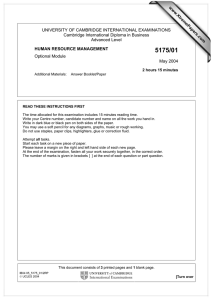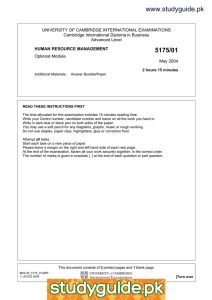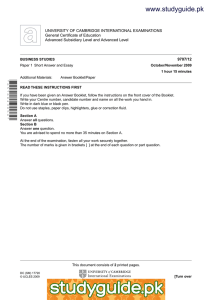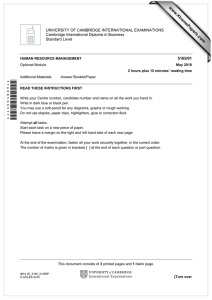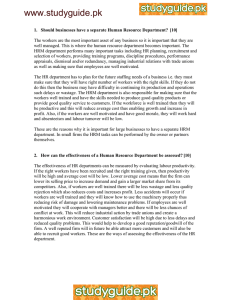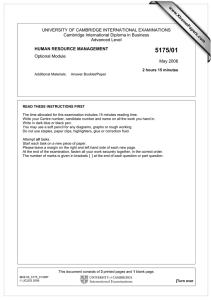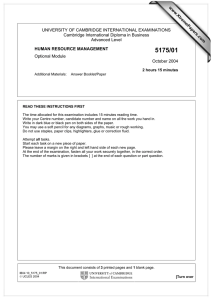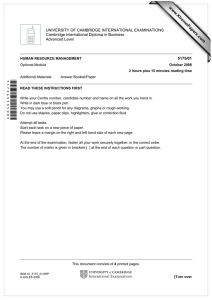www.XtremePapers.com
advertisement
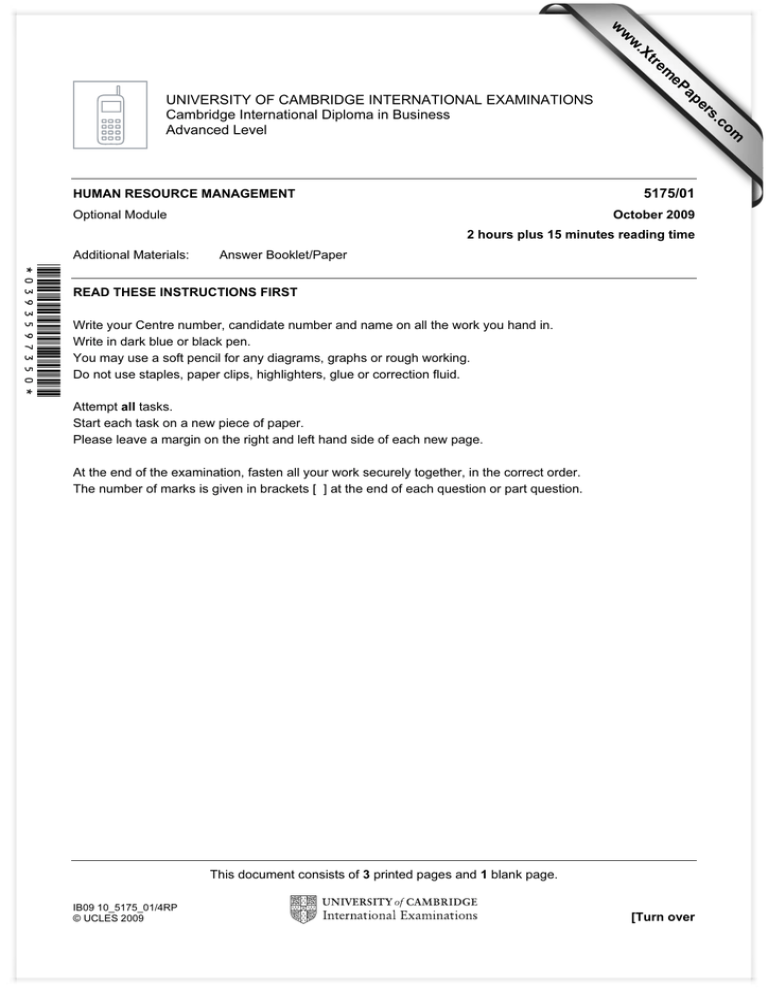
w w ap eP m e tr .X w om .c s er UNIVERSITY OF CAMBRIDGE INTERNATIONAL EXAMINATIONS Cambridge International Diploma in Business Advanced Level 5175/01 HUMAN RESOURCE MANAGEMENT Optional Module October 2009 2 hours plus 15 minutes reading time Additional Materials: Answer Booklet/Paper *0393597350* READ THESE INSTRUCTIONS FIRST Write your Centre number, candidate number and name on all the work you hand in. Write in dark blue or black pen. You may use a soft pencil for any diagrams, graphs or rough working. Do not use staples, paper clips, highlighters, glue or correction fluid. Attempt all tasks. Start each task on a new piece of paper. Please leave a margin on the right and left hand side of each new page. At the end of the examination, fasten all your work securely together, in the correct order. The number of marks is given in brackets [ ] at the end of each question or part question. This document consists of 3 printed pages and 1 blank page. IB09 10_5175_01/4RP © UCLES 2009 [Turn over 2 You must read the case study below and attempt ALL the tasks which follow. (The case study is fictitious.) THE CLEAN OIL COMPANY PLC (COplc) Clean Oil plc (COplc) was founded in 2008 as a result of a merger between three oil companies, Southern Oil situated in South America, Central Oil situated in central Asia and Standard Oil situated in North Africa. The name was chosen to portray a ‘greener’ image and to capture a larger share of the market. The first step after the merger had taken place was to commission a report on all aspects of the 5 business by a team of consultants. Extracts from the report on the Human Resource Management (HRM) of the company are as follows: The Human Resource Management (HRM) of all of the original companies was excellent with many examples of good practice but it would not be wise to centralise all of the functions as was suggested during the merger. The reason for this is that the three parts (plants) of COplc are 10 spread across the world and so the operational HRM needs to be carried out locally. For the Head Office (HO) to recruit and select staff for all locations would be difficult. Plant 1 in South America has a large local labour force that is unskilled and dominated by males aged 30-50 years with the majority working in the primary sector. Plant 2 in North Africa, has a small labour force with a high level of technical skills and a good standard of education. It is male dominated but the age range 15 is 25-40 years. Plant 1 has to recruit from a wider geographical area than Plant 2, but Head Office would not be aware of this. We believe that it is practical for the new Head Office to take control of the meaning and strategic purpose of HRM. The company should also consider the changes that are taking place in HRM, especially the increased welfare function, and begin to adapt its approach to improve HRM in each 20 of the three plants. In our view, the rapid development of technology within the industry may cause the company problems in the next five years and Human Resource planning is essential. We would recommend two strategies to combat the growth of technology: • firstly, the adoption of a redundancy policy, the use of fixed-term contracts and a complete 25 assessment of the age profile of the staff • secondly, the adoption of a comprehensive training policy that embraces the concept of lifelong learning. The company should consider the following: • the use of different working structures other than the geographical and functional structures that exist at present • the introduction of an improvement mechanism such as Total Quality Management (TQM) • the rationalisation of the present payment methods to a single system of fixed rates for technical staff, piece rates for production staff and a share option scheme for all • the use of external trainers • the development of formal consultation and negotiation systems at all of the three plants. 30 35 The team has a number of reservations concerning the present use of market forces to determine wage and salary levels in each plant. A uniform system would be preferable but it is understood that COplc are in a competitive market and the market conditions around the world can be quite different. We therefore recommend that the HRM section of COplc critically review the present 40 policy. © UCLES 2009 5175/01/O/09 3 You must attempt ALL of the following tasks. Where appropriate use information from the case study to support your answer. 1 (a) Explain how the Head Office of COplc can continue with the strategic purpose of HRM. [5] (b) Explain what the consultants mean by the phrase ‘the changes that are taking place in HRM’ (line 19). [5] (c) Explain why the consultants believe that the operational purpose of HRM needs to be carried out locally. [10] [Total: 20] 2 (a) Explain the concept of lifelong learning in the context of COplc. [5] (b) Describe the differences and similarities between the labour market at Plant 1 (South America) and Plant 2 (North Africa). [5] (c) Explain the effect of the differences in the labour market faced by COplc in Plant 1 (South America) and Plant 2 (North Africa). [10] [Total: 20] 3 (a) Explain why COplc needs Human Resource (HR) planning. [5] (b) Explain the difference between the use of a redundancy policy and the use of fixed-term contracts. [5] (c) Explain how the two strategies outlined by the consultants might help COplc to combat the growth of technology. [10] [Total: 20] 4 (a) Describe two working structures that COplc might use. [5] (b) Explain how COplc might use TQM. [5] (c) Explain in detail how COplc presently determines the wage and salary levels of its staff. 10] [Total: 20] 5 (a) Explain how the following schemes might operate: (i) a piece-work payment; [2] (ii) a share option scheme. [2] (b) Explain the benefits of using external trainers. [6] (c) Explain why the establishment of formal consultation and negotiation systems would benefit COplc. [10] [Total: 20] © UCLES 2009 5175/01/O/09 4 BLANK PAGE Permission to reproduce items where third-party owned material protected by copyright is included has been sought and cleared where possible. Every reasonable effort has been made by the publisher (UCLES) to trace copyright holders, but if any items requiring clearance have unwittingly been included, the publisher will be pleased to make amends at the earliest possible opportunity. University of Cambridge International Examinations is part of the Cambridge Assessment Group. Cambridge Assessment is the brand name of University of Cambridge Local Examinations Syndicate (UCLES), which is itself a department of the University of Cambridge. 5175/01/O/09
